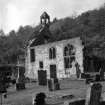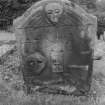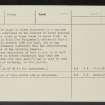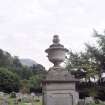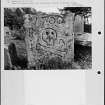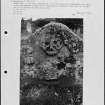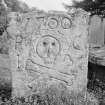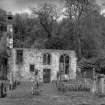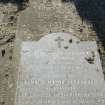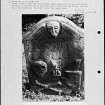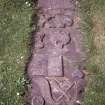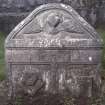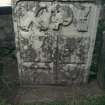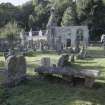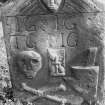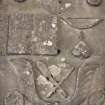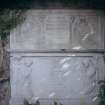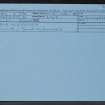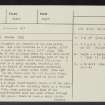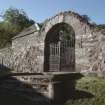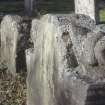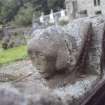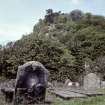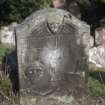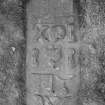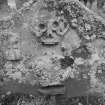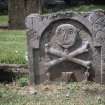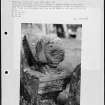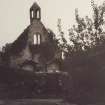Logie Old Church
Burial Ground (16th Century), Church (Post Medieval), Hogback Stone(S) (Medieval), Sundial (17th Century), Unidentified Pottery(S) (Medieval)
Site Name Logie Old Church
Classification Burial Ground (16th Century), Church (Post Medieval), Hogback Stone(S) (Medieval), Sundial (17th Century), Unidentified Pottery(S) (Medieval)
Canmore ID 47164
Site Number NS89NW 8
NGR NS 81522 96976
Datum OSGB36 - NGR
Permalink http://canmore.org.uk/site/47164
- Council Stirling
- Parish Logie (Stirling)
- Former Region Central
- Former District Stirling
- Former County Stirlingshire
NS89NW 8.00 81522 96976
NS89NW 8.01 8154 9696 Hog-Back Stones
(NS 8152 9697) Church (NR)
OS 6" map (1958)
Only a fragment now remains of the old parish church of Logie. All that survives is a W gable, 24'6" wide, and the W part of the S wall, 30'6" long. The original length of the building seems to have been about 56', and it had a N aisle. The surviving part of the S wall contains a square-headed door about its centre. W of the door there is a small window, evidently not original as it is formed of heterogeneous materials including, as the sill, a stone dated 1598. This was found in 1874 in the ruins near the old Session House, at the E end of the church, (R M Ferguson 1905) and had no doubt come from an earlier church.
There is a large round-headed window E of the door. On the SW angle of the building there is a tabular sundial dated 1684, very probably the date of the building. A square-headed door has been broken through the centre of the gable; there is also a small round-headed window.
A church of Logie is first mentioned in a charter in which it is confirmed to the convent of North Berwick; this charter is dated by Cosmo Innes to about 1178. No authority can be found for Fergusson's statement that a church was built between 1380 and 1480, and it may simply be an erroneous inference from the architectural characteristics of the existing remains.
The supposed dedication of this church to St Serf appears to have no better foundation than that the miracle connected with this saint's ram is said to have been performed at Airthrey, in this parish. (See also NS89NW 8.01 for tombstones).
RCAHMS 1963, visited 1952
The remains of this church are as described.
Visited by OS (JP) 20 December 1973
EXTERNAL REFERENCE:
Scottish Record Office
LOGY. Building of a rectory and parsonage.
Resignation by the prioress of the Abbey of North Berwick of the Kirk of Logy so that the King may erect the rectory and parsonage.
1596 GD158/307
Expense of reparation of the Kirk and debts owing to the workmen for the reparation of the Manse.
Meeting of the Heritors to consider the cost and how it should be shared among them.
1706 GD 189/5/1
Field Visit (23 August 1952)
NS89NW 815 969 ‘Church’
Old Church and Graveyard, Logie.
Of the old parish church only a fragment now remains (Pl. 13 A). It stands on the right bank of the Logie Burn, close to the point where this must have been crossed by the old road described under No. 509 and some 350 yds. NW. of its successor (NS89NW 51). All that survives is a W. gable, 24 ft. 6 in. wide externally, and the W. part of the S. wall, extending to a length of 30 ft. 6 in.; the original length of the building seems to have been about 56 ft., and it had a N. aisle (1). The surviving part of the S. wall contains, about its centre, a square-headed door with a back-set and widely chamfered architrave, and above this a small round-headed window divided by a mullion into two lancet-shaped lights with glazing-grooves. To the E. there is a large round-headed window showing two similar lights but subdivided by a transom; the lower part of the E. light has been checked and hinged externally for a shutter. West of the door there is a small window, evidently not original as it is formed of heterogeneous materials including, as the window-sill, a stone bearing the date 1598 in raised letters on a sunk panel; this was found in 1874 ‘in the ruins near the old Session House, at the east end of the church’ (2), and had no doubt come from an earlier church. Close to the gable, and at an upper level, there is a gallery doorway with a back-set architrave, and checks for an external door; it must have been reached by an outside stair, now removed. On the SW. angle of the building there is a tabular sundial, bearing the date 1684, very probably the date of the building. The W. gable has plain skews and, on the S., a rolled skewput; it is topped by a square bell-cote with Classical pillars and a pyramidal top. A square-headed door, checked and hinged externally, has been broken through the centre of the gable, and high up in it there is a small round-headed window similar to the one in theS. wall. Reset above the door there is a panel with a moulded border bearing, above, an inscribed plaque and, below, a shield with helm and mantling and, for crest, a crowned heart. The shield is charged, for Douglas: three piles, in chief three mullets. The inscription reads THIS MANSE WAS BUILDED AT / THE EXPENSES OF THE HERITOURS / OF LOGIE AND OF MR A L DOUGLAS / MINISTER THERE ANNO D 1698 / I AND MY HOUSE WILL SERUE / THE LORD JOSHUA 24 V 15, and on a ribbon below appear the Greek words TA ANΩ (‘The things that are above’). A modern inscription states that this panel was removed from the old manse in 1804.
A church of Logie is first mentioned in a charter of Simeon, bishop of Dunblane, in which its possession is confirmed to the convent of North Berwick (3). This charter is dated by Cosmo Innes to about 1178 (4). Subsequent mentions of the church before the Reformation are given by Menzies Fergusson (5) ; but no authority can be found for his statement that a church was built between 1380 and 1420, and it may be simply an erroneous inference from the architectural characteristics of the existing remains. In 1596 Dame Margaret Hume, prioress of North Berwick, resigned the convent's surviving properties, including Logie Church, to the King for ‘the sustentatione of the minister serving the cure thairat and utheris godlie usis’ (6). The post Reformation history of the parish is also given by Menzies Fergusson (7). The supposed dedication to St. Serf appears to rest on no better foundation than that the miracle connected with this saint's ram is said to have been performed at Athren (Airthrey), which is in this parish (8).
RCAHMS 1963, visited 23 August 1952.
[see the original text for a description of the hog-backed stone and 13 gravestones, along with a note on almost 100 others]
(1) Fergusson, R. Menzies (Logie, A Parish History, i, 205 n), gives the internal dimensions as approximately 56 ft. by 21 ft., and states that the aisle was 19ft. square.
(2) Ibid., 11, n.
(3) Carte Monialium de Northberwic, Bannatyne Club, 6 (No. 5).
(4) Ibid., xxx.
(5) Op. cit., i, 11 ff.
(6) Carte Monialium de Northberwic, xv.
(7) Op. cit., i, 20 ff.
(8) Wyntoun, Orygynale Cronykil of Scotland, ii, 40 (The Historians of Scotland, iii).
Field Visit (August 1978)
Logie, Old Parish Church, Burial-ground and Hogbacks NS 815 969 NS89NW 8
There was a church here by about 1178 and in the churchyard are two hogbacks of 11th century date. The remains now standing within the oval churchyard are probably those of a church built in 1684.
RCAHMS 1979, visited August 1978
(RCAHMS 1963, pp. 118-22, no. 1 27; Cowan 1967, 136; Lang 197 4, 228)
Excavation (7 June 2010)
NS 81521 96977 (centred on)
A series of four test pits were excavated against the N, E and S walls of the church on 7 June 2010. The current church which dates from 1684 is undergoing structural repairs and the test pits were dug to allow a structural assessment of the foundations. The walls, of dressed rubble, were founded on fragmented and rounded small to large rubble of up to 0.7m in depth. Finds included a few sherds of late/post medieval pottery and some disarticulated human bone (reburied on site). The first record of a church on this site is in the charter of 1178, but no remains of walls pre-dating the 1684 church were identified.
Archive: RCAHMS
Funder: Brownriggs
Ray Cachart, Alder Archaeology Ltd.
Artefact Recovery (2020)
NS 81522 96976 In 1927, A D Lacaille visited Logie Old Church and recorded the presence of two peculiar ‘hog-backed’ stones. The first (Logie 1) is complete and lies just to the SE of the old church. The second (Logie 2), which is a fragment, was discovered in a stream to the E of the church. Lacaille thought this fragment was one of three pieces of a once-complete hogback he was told was deliberately broken in the early 20th century and thrown down the embankment. Lacaille finishes his entry by noting that he placed Logie 2 beside Logie 1, and this is where the mystery of the Logie hogbacks begins.
Logie 1 remains in the same location today as previously recorded by Lacaille, and it was subsequently recorded by the RCAHMS and James Lang. Unfortunately, however, both Lang and the RCAHMS appear to have been unable to correctly identify Logie 2. This misfortune has resulted in both referring to a lumpy stone set as a headstone at the N end of row 6 as likely being Logie 2. This is a strange assumption as this stone does not match Lacaille’s description of Logie 2, which he noted as being decorated with two rows of triangular tegulation. Logie 2 was, therefore, clearly ‘lost’ sometime after Lacaille placed it beside Logie 1.
Further complicating the hogback evidence at Logie, there is a mixed pile of carved stone fragments beside Logie 1, decorated with rows of two different types of tegulation. As with the lumpy stone above, none of these fragments matches Lacaille’s description of Logie 2, nor do they represent likely fragments of what would be the missing pieces of Logie 2 because the tegulation and form appear to be different. To complicate matters even further, this collection of stone fragments has also been referred to as Logie 2.
During a recent site visit as part of a doctoral research project, a potential hitherto unknown hogback fragment was discovered. This fragment is built into the eastern wall-head of the old church and was preliminarily named ‘Logie 3’. A further site visit with Sally Foster and Rod McCullagh followed to reassess this fragment, and it quickly became apparent that ‘Logie 3’ was likely to be the ‘lost’ Logie 2. Although the rediscovered Logie 2 fragment is difficult to assess due to it being built into a wall-head, it does appear to be the end portion of a hogback. It is decorated on both sides with a least two rows of tegulation, and so it conforms with Lacaille’s description. In terms of Lang’s typology, it is likely a fragment of an 11th-century hogback of the Scottish Type B2 – Plain Tegulated Type. This new understanding means that the preliminary identifications of the stones recently considered to be the ‘lost’ Logie 2 and ‘Logie 3’ are now incorrect, and this entry should serve as both a correction and update.
The mixed pile contains three carved stones that appear to belong together and are decorated on one side with tegulation that appears different from Logie 2. Could these be the stones that Lacaille was told were thrown onto the stream bank, and part of a different monument? A fourth stone bears tegulation of a different type. It is not known when and how this pile of stones was accumulated in the graveyard, but presumably since Lang visited.
The Logie carved stone collection thus contains not two but a minimum of four stones: one complete hogback (Logie 1), one end portion of a hogback (Logie 2), and fragments of at least two other decorated stones. Digital survey of all the Logie fragments will help to resolve how many hogbacks are represented by the surviving decorated stones. I am grateful to Sally and Rod for their helpful observations and for allowing me the use of their photographs. (See Front Cover, Image 2).
Jamie Barnes – Historic England
(Source: DES Volume 21)
Archaeological Evaluation (1 October 2021 - 2 October 2021)
NS 81520 97003 An evaluation to the N of the boundary of Logie Old Kirk (Canmore ID: 47164) was undertaken, on 1–2 October 2021, to establish the presence or absence of an earlier boundary ditch. A 2 x 1m trench was opened, which located a Victorian midden, an earlier wall, and ditch which contained Scottish post-medieval reduced ware. The feature was not bottomed due to rainfall and the intention is to return to the site in 2022. At the same time seven small 0.3m dimeter and 0.5m deep test-pits were dug with Scheduled Monument Consent, in advance of a new fence, in the NE corner of the churchyard. These test-pits did not recover any pottery, charnel or in situ skeletons.
Archive: Stirling SMR Funder: Private individual
Murray Cook – Stirling Council
(Source: DES Vol 22)
Archaeological Evaluation (3 August 2022 - 11 October 2022)
NS 81520 97003 A return to the N boundary of Logie Old Kirk, in late summer 2022, to continue to explore evidence for an older boundary. This has identified an older, possibly medieval, wall, which had a later post-medieval building attached to it, which seals cut features.
Archive: Stirling HER (intended) Funder: Murray Cook
Murray Cook – Rampart Scotland
(Source: DES Volume 23)








































